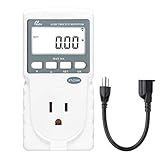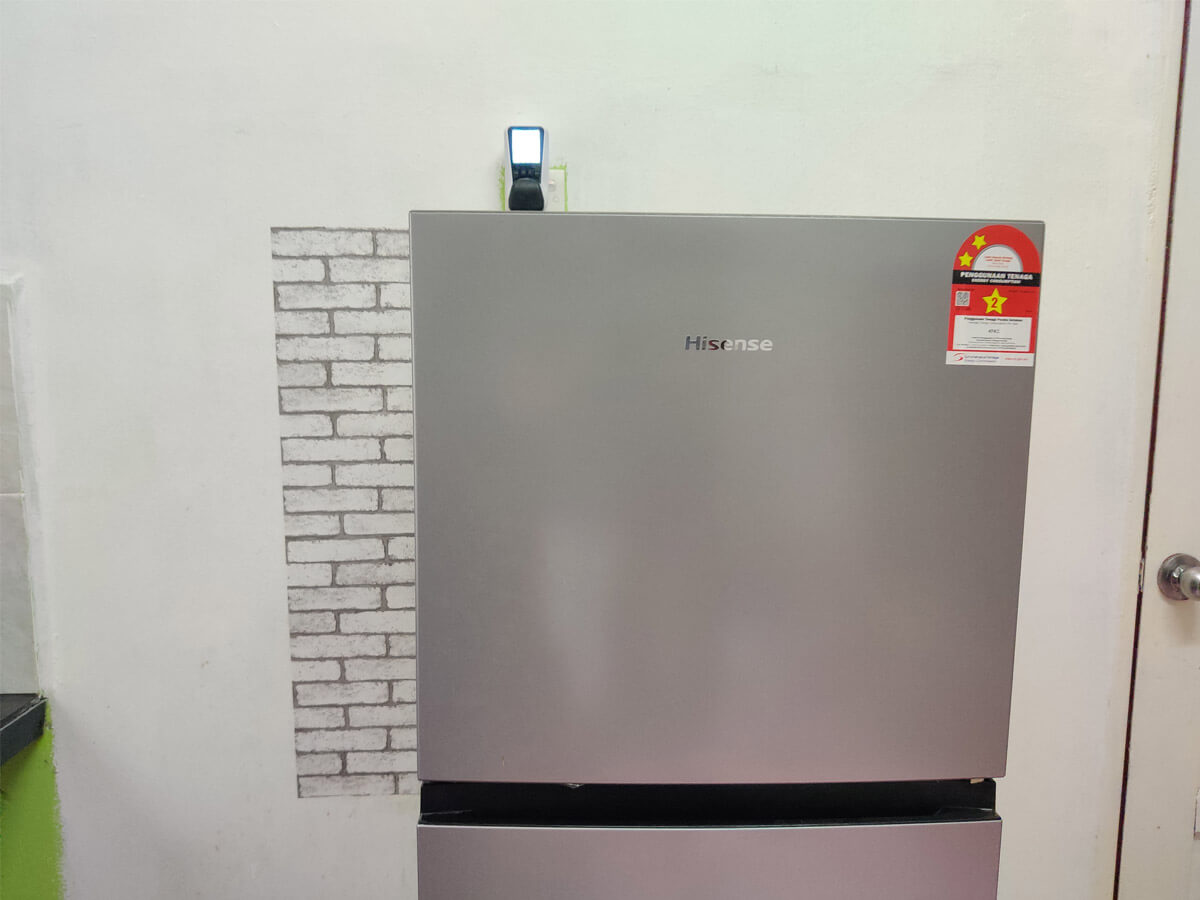
Whether you’re looking to run your refrigerator on solar power, or backup batteries, or just want to know the cost of running it, understanding its electricity usage is the first step.
Now, the amount of electricity your fridge consumes depends on its size and energy efficiency, but it’s also affected by operating conditions like ambient temperature, temperature settings, how often you open the door, and how full the fridge is.
To start off, here’s a table that provides a rough estimate of Power Usage (Watts) and Energy Consumption (kWh) for refrigerators, categorized by their capacity:
| Capacity (Cubic feet, Liters, and Quarts) | Estimated Power Usage (Watts) | Estimated Daily Energy Consumption (kWh/day) |
| 4 ft 3 (115 L) (120 QT) | 50 – 100 Watts | 0.4 – 1 kWh/day |
| 7 ft 3 (200 L) (210 QT) | 80 – 180 Watts | 0.6 – 1.4 kWh/day |
| 10 ft 3 (280 L) (300 QT) | 120 – 250 Watts | 1 – 2 kWh/day |
| 14 ft 3 (400 L) (420 QT) | 180 – 300 Watts | 1.5 – 3 kWh/day |
| 20 ft 3 (560 L) (600 QT) | 250 – 450 Watts | 2 – 4 kWh/day |
| 25 ft 3 (700 L) (750 QT) | 300 – 600 Watts | 2.5 – 5 kWh/day |
The Wattage (Watts) and Energy Consumption (kWh) estimates provided in the table are based on the electrical specifications and EnergyGuide labels of over 30 different refrigerators.
For instance, an older, energy-inefficient 25 Cu. ft. refrigerator might draw around 600 Watts during operation, consuming an average of 5 kWh per day. On the flip side, a newer, more energy-efficient model of the same size won’t go beyond 300 Watts and can use as little as 2.5 kWh per day.
But these estimates aren’t exactly pinpoint accurate, are they?
Well, if you’d like to determine the electricity usage of your fridge more accurately, check out the detailed guide in the following article. You might also find it helpful to kick things off by watching a video I created on this:
I get commissions for purchases made through links in this post.
The electricity usage of your refrigerator: Power (Watts) vs Energy (kWh)
The electricity usage of a refrigerator involves a couple of key aspects, with the most important being:
- Electrical Power Usage, or the Wattage of the refrigerator, which is measured in Watts.
- Electrical Energy Consumption of the fridge, which is measured in Watt-hours (Wh) or kiloWatt-hours (kWh).
1. The Electrical Power Usage of the refrigerator:
Measured in Watts, a fridge’s Power Usage, often referred to as its “Wattage”, represents the rate at which it consumes electricity.
For instance, a 10 Cu. ft. refrigerator might only draw 150 Watts of power, while a larger 20 Cu. ft. fridge will require around 300 Watts because of its size, demanding more electrical force to operate.
The Wattage of your refrigerator becomes especially important if you’re sizing equipment to power the fridge, like an inverter or generator.
For example, if you’re trying to run your refrigerator using an inverter and it draws up to 400 Watts of power, the inverter should be rated at 400 Watts or more. Otherwise, it won’t generate enough force to effectively operate the refrigerator.
The same goes for a gas or a solar generator.
2. The Electrical Energy Consumption of the refrigerator:
Measured in Watt-hours (Wh), or more commonly kiloWatt-hours (kWh), the Energy Consumption of your fridge indicates the actual quantity of electricity it uses over a specific timeframe, such as per day.
For instance, a 10 Cu. ft. refrigerator might only consume 1 kWh of energy per day, while a 20 Cu. ft. fridge could use 2 kWh of energy during the same period.
Understanding the energy consumption of your refrigerator is not only helpful in calculating operational costs, as utility providers use it to measure electricity usage and determine monthly charges, but it’s also crucial if you’re considering running your refrigerator on solar panels or batteries.
This equipment is sized based on the amount of electrical energy needed.
For example, if you plan to power your refrigerator with solar panels and it consumes 3 kWh of energy per day, you’ll require a solar array that produces 3 kWh/day or more—typically, a 600W system or larger.
Explore this article to delve deeper into the distinction between power and energy.
How many Watts does your refrigerator use?
Determining the Wattage of your refrigerator is straightforward—just refer to the electrical specification label or nameplate usually located inside the fridge.
On the nameplate, you’ll typically find the Wattage specified as “Rated Power” or “Rated Input” with a “W” next to the value, indicating Watts.
Although, in some instances, the Wattage might not be explicitly mentioned. Instead, the nameplate might provide a “Rated Voltage” in Volts (V) and a “Rated Current” in Amps (A).
In such cases, you can calculate the Wattage of the refrigerator using these electrical specifications:
Rated Power (Watts) = Rated Voltage (Volts) x Rated Current (Amps)
For example, let’s take a look at this electrical specifications label inside my refrigerator:
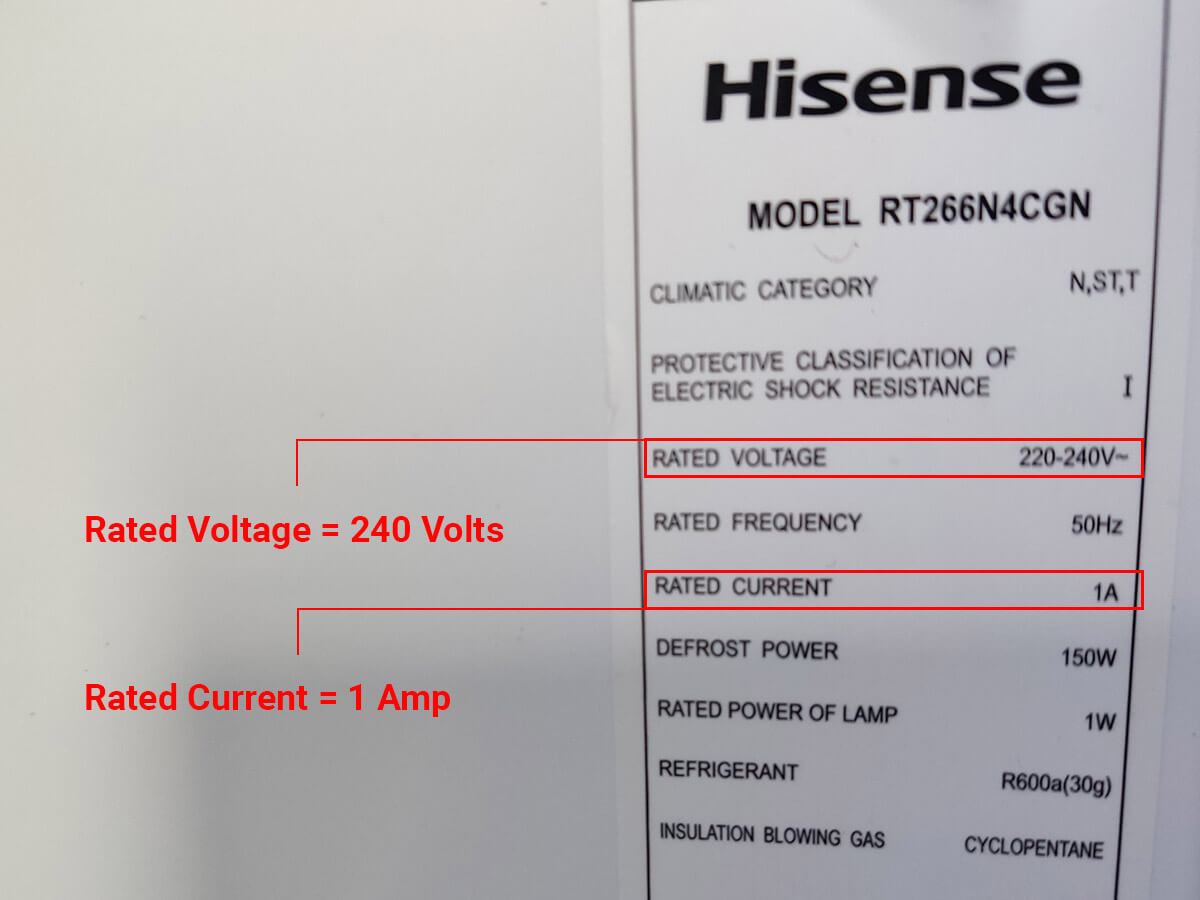
With these electrical specifications, I can calculate the Rated Power of my fridge as follows:
Rated Power (Watts) = Rated Voltage (Volts) x Rated Current (Amps)
Rated Power (Watts) = 240 Volts x 1 Amps
Rated Power (Watts) = 240 Watts
What we’ve just calculated represents the maximum power the fridge should use when running. In other words, during its operation, my refrigerator should not draw more than 240 Watts of power.
However, it’s important to note that this Rated Power represents the “Running” Wattage. Refrigerators and most appliances with a motor also have a “Starting” Wattage, which is the power required by the motor to gain momentum when turning on.
This Starting Wattage is typically 2 to 6 times the Running Wattage and should be considered if you’re planning on running your refrigerator on an inverter or generator.
Learn more about sizing an inverter for your fridge here.
On your refrigerator’s nameplate, you might also find an additional wattage rating specified as “Defrost Power”, “Defrosting Input”, “Heater Input”, or a similar term.
For instance, one of the specifications for my refrigerator is a “Defrost Power” input of 150 Watts:
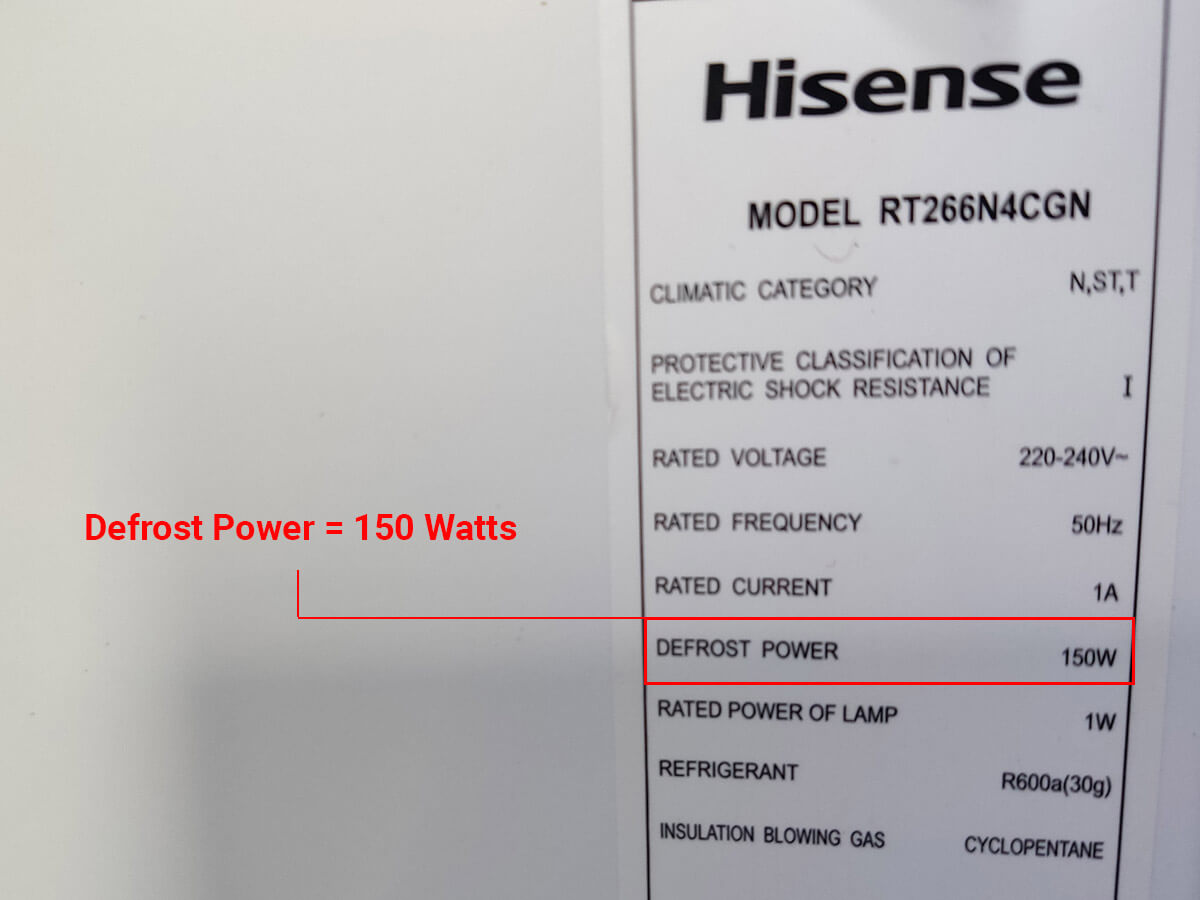
This particular rating represents the amount of power that the defrosting heater element uses to melt the ice that accumulates on the cooling coils, while what we’ve calculated previously, or what is typically specified as the “Rated Power”, is the wattage of the compressor, which is the main component inside the fridge responsible for the cooling.
The compressor and the heating element do not operate at the same time, so, you don’t have to worry about this defrost power rating unless it’s greater than the rated power of your refrigerator.
How much energy (kWh) does your refrigerator use?
A household refrigerator ranging from 20 to 28 Cu. ft (570 – 800 L) usually uses about 2.5 to 3.5 kWh of energy per day, totaling around 750 to 1000 kWh per month.
However, as previously explained, the real electricity consumption of your refrigerator isn’t solely determined by its size. It also depends on its energy efficiency and operating conditions, influencing how much effort the refrigerator has to put in to maintain its internal temperature.
Now, there are three different ways to measure or at least get a ballpark figure of your refrigerator’s electricity usage.
1. Use an electricity monitoring device:
The most reliable method to determine your refrigerator’s electricity usage is to measure it using an electricity monitor. These devices are cheap, very easy to use, and provide accurate measurements of energy consumption over time.
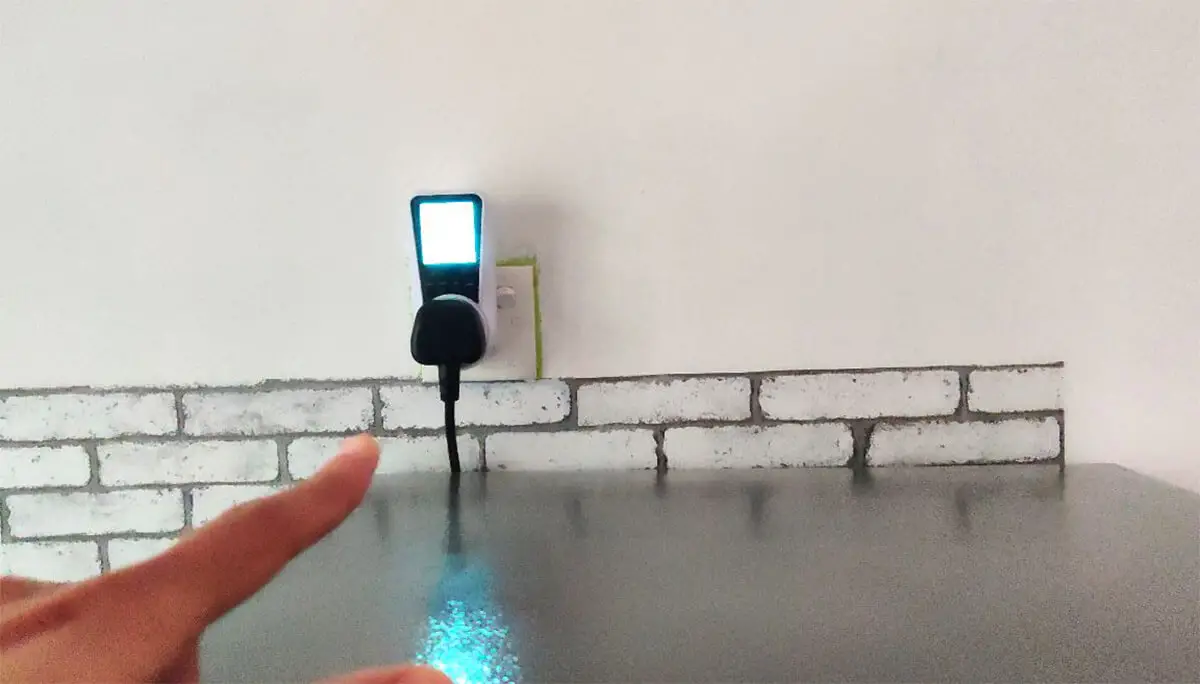
For example, I plugged my energy monitor into the outlet, and plugged my refrigerator into it, waited 24 hours, and here are the results:
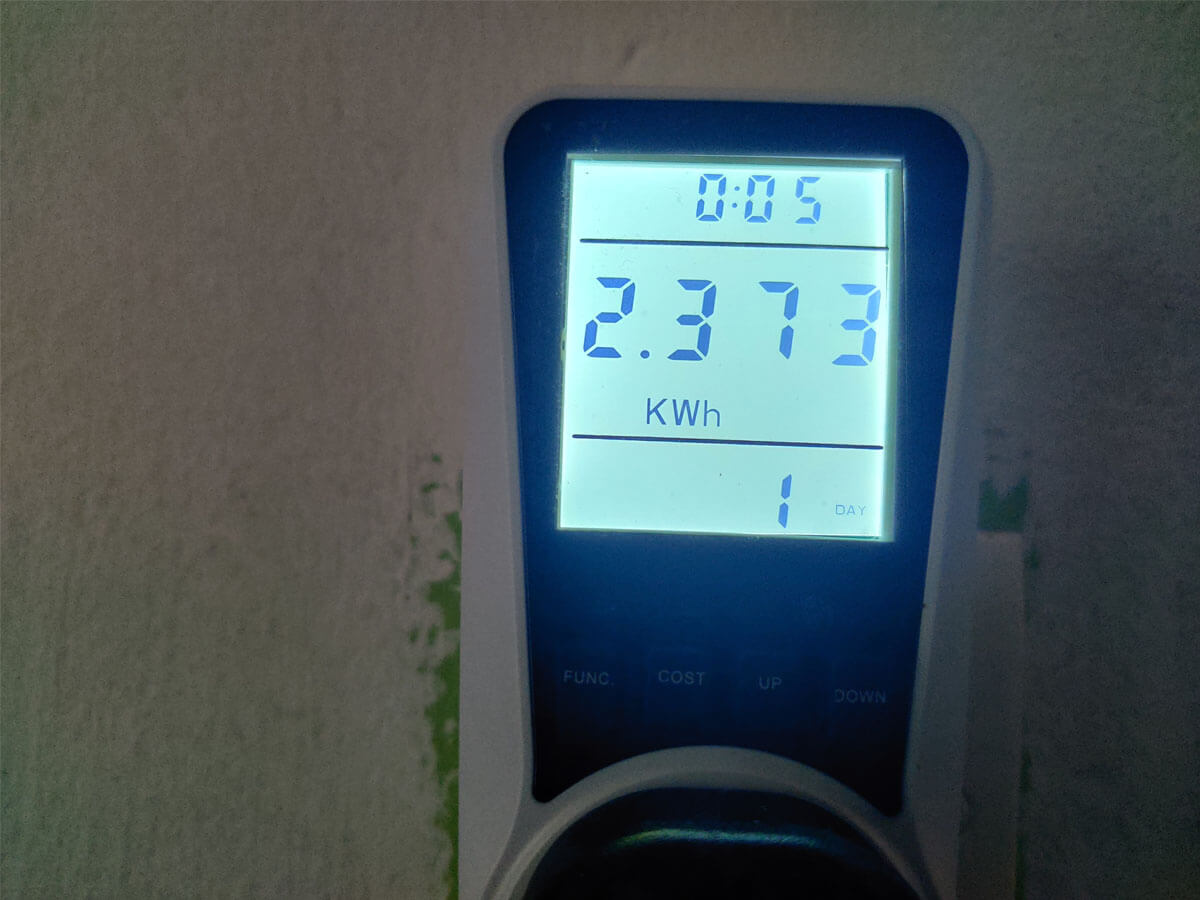
According to the metering device, my refrigerator consumed 2.373 kWh of energy during a period of 24 hours, which equates to 2373 Watt-hours of energy.
2. Use the “Estimated Yearly Energy Use” provided by the manufacturer:
If you’re in the U.S., there’s a good chance your refrigerator had an EnergyGuide label on it when you bought it. This label provides an estimate of the fridge’s annual energy consumption:
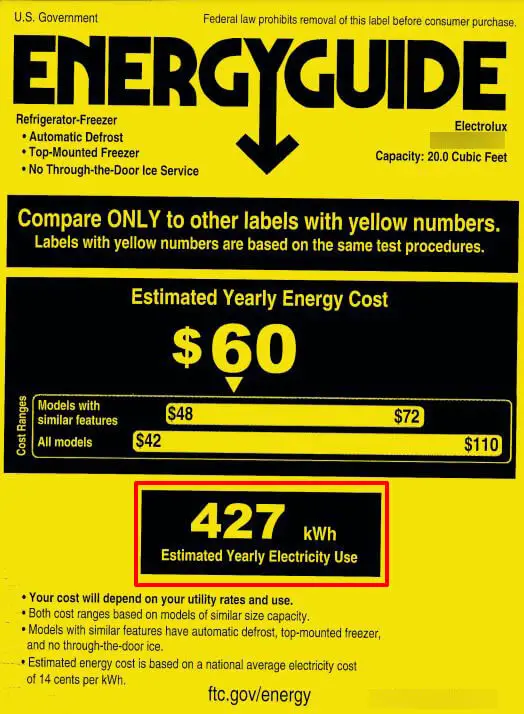
This estimate is primarily useful for comparing different units on the market and may not be 100% accurate as it doesn’t consider specific usage and operating conditions, but it provides a useful reference.
To break it down further, you can use the “Yearly Electricity Use” to estimate monthly and daily energy consumption:
Estimated Monthly Energy Consumption (kWh/month) = Estimated Yearly Electricity Usage (kWh/year) ÷ 12
Estimated Monthly Energy Consumption (kWh/month) = 427 kWh/year ÷ 12
Estimated Monthly Energy Consumption (kWh/month) = 35.58 kWh/month
And for daily consumption:
Estimated Daily Energy Consumption (kWh/day) = Estimated Yearly Electricity Usage (kWh/year) ÷ 365
Estimated Daily Energy Consumption (kWh/day) = 427 kWh/year ÷ 365
Estimated Daily Energy Consumption (kWh/day) = 1.17 kWh/day
Keep in mind, that these estimates are spread out over the whole year. So, when summer rolls in, and it gets hotter, your fridge has to put in more effort, using up more energy.
For example, the label on my refrigerator estimates that it consumes 474 kWh of energy per year, which should translate to an average daily energy consumption of around 1.3 kWh.
But as shown above, after measuring the actual energy usage of my fridge, it turns out it consumes 2.4 kWh per day. That’s about 80% more, mainly because it was running in a room at a toasty 83°F – 90°F (28°C – 33°C) that day.
3. Use the Rated Power of your refrigerator:
Electrical Power and Electrical Energy are interconnected and the relationship between them is as follows:
Electrical Energy (Watt-hours) = Electrical Power (Watts) x Time (hours)
For instance, let’s take a 50-Watt light bulb. If it’s left on for 5 hours, the energy it consumes by the end of that period is calculated like this:
Energy Consumption (Watt-hours) = Power Usage (Watts) x Time (hours)
Energy Consumption (Watt-hours) = 50 Watts x 5 hours
Energy Consumption (Watt-hours) = 250 Wh
And in kiloWatt-hours (kWh):
Energy Consumption (kiloWatt-hours) = 250 Wh ÷ 1000
Energy Consumption (kiloWatt-hours) = 0.25 kWh
Now, the same principle applies to refrigerators, except that, refrigerators don’t operate or draw power 100% of the time.
The compressor inside the refrigerator will cycle ON and OFF in a way that allows the fridge to maintain its internal temperature. Over 24 hours, the refrigerator will only draw power for about 8 to 12 hours.
So, a good rule of thumb for calculating the daily energy consumption of your refrigerator is to use 12 hours instead of 24 hours:
Daily Energy Consumption (Watt-hours) = Power Usage (Watts) x 12 hours
For example, my refrigerator is rated at 240 Watts, so its daily energy consumption can be estimated as follows:
Daily Energy Consumption (Watt-hours) = Power Usage (Watts) x 12 hours
Daily Energy Consumption (Watt-hours) = 240 Watts x 12 hours
Daily Energy Consumption (Watt-hours) = 2880 Wh
Daily Energy Consumption (kiloWatt-hours) = 2.88 kWh
Usually, this might give you a bit more than what your fridge actually uses, but in this context, it’s better to overestimate than underestimate, especially if you’re sizing equipment.
How much does it cost to run your refrigerator?
To give you a ballpark figure, here’s a table estimating the daily and monthly costs of running refrigerators based on their capacity:
| Capacity (Cubic feet, Liters, and Quarts) | Estimated Daily Cost ($/day) | Estimated Monthly Cost ($/month) |
| 4 ft 3 (115 L) (120 QT) | $0.06 – $0.15 | $1.8 – $4.5 |
| 7 ft 3 (200 L) (210 QT) | $0.1 – $0.22 | $3 – $6.5 |
| 10 ft 3 (280 L) (300 QT) | $0.15 – $0.3 | $4.5 – $9 |
| 14 ft 3 (400 L) (420 QT) | $0.25 – $0.5 | $7.5 – $15 |
| 20 ft 3 (560 L) (600 QT) | $0.32 – $0.65 | $10 – $20 |
| 25 ft 3 (700 L) (750 QT) | $0.4 – $0.8 | $12 – $24 |
These estimates are based on the average cost of electricity for residential consumers in the U.S., which, according to the Energy Information Administration (EIA), is around 16 cents per kWh.
However, your actual cost depends on two main factors:
- The energy usage of your fridge.
- The cost of electricity in your location.
You can calculate the cost using the formula:
Cost ($) = Energy Consumption (kWh) x Cost Per kWh ($/kWh)
Daily Cost ($/day) = Daily Energy Consumption (kWh/day) x Cost Per kWh ($/kWh)
Monthly Cost ($/month) = Monthly Energy Consumption (kWh/month) x Cost Per kWh ($/kWh)


